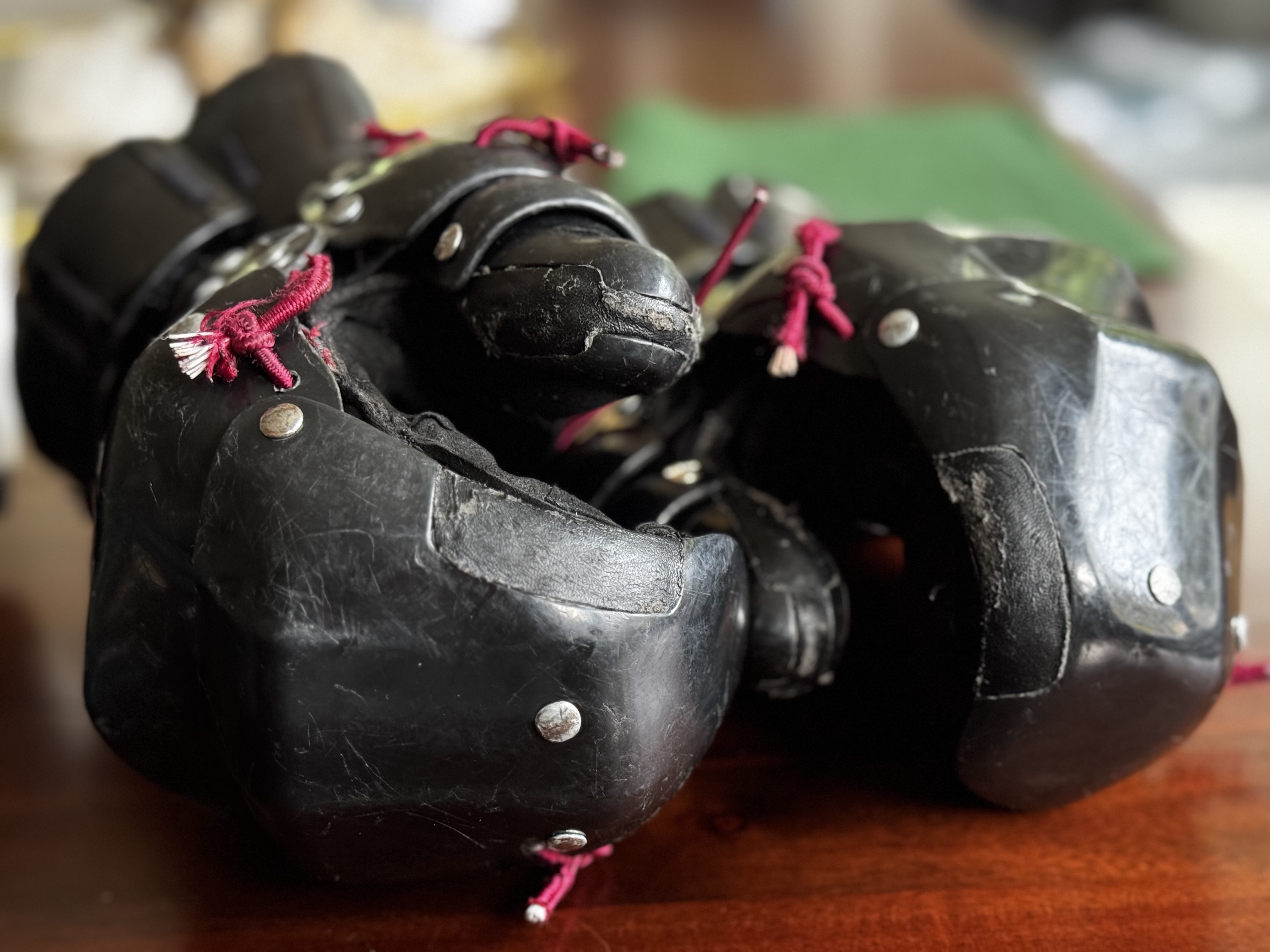
Posted: 01 December 2024 | Last modified: 05 March 2025 | Expires: 28 August 2027
The CHFG Michaels are a clamshell-style heavy glove for HEMA manufactured in China. They’re the second model of glove released by CHFG (the five-fingered Gabriels are the first), and the Michaels share a number of attributes with the Gabriels. Whereas the latter are not as protective for intensive longsword play, however, the Michaels offer better protection for individual fingers, and come in $50 cheaper due to less complexity. The Michaels are sold in the US only through SoCal Swords, as PurpleHeart thus far refuses to stock them as they claim to already sell comparable gloves (presumably referring to SPES Lobsters and HF Black Knights).
I picked up a pair of Michaels in early June, 2024, after becoming frustrated with two back-to-back warranty replacements for Black Knights, and my veteran pair of Black Knights immediately thereafter losing a thumb plate. Normally I would have waited for more long-term use reports on the Michaels before ordering them myself, but I didn’t want to wait on Black Knights in my size restocking, and I hadn’t yet fixed my old pair of Black Knights, so I figured I’d try another heavy glove in the meantime since they happened to be in stock at the right time.
I published this review a bit earlier than I initially intended, but in this case, around six months of use established what the durability issues are, and enough people ask about these compared to other heavy gloves that I wanted to get the write-up out there.

As with other heavy gloves, sizing guidelines can be a bit questionable, as I explained in my review of the Black Knights. Rumor was that CHFG’s gloves ran small, and I found myself between sizes L and XL using their sizing chart. A friend’s Gabriels in XL fit me great when new, but felt large after being worn in, but another friend’s L felt like the finger pockets were too short for me. Sizing for the Michaels was a tad easier, and I decided to go for the Ls, which I’m glad I did because they seem to fit fine. As with other gloves, once the inner glove begins to stretch out some, closing one’s hand tends to results in the finger tips no longer being seated at the very end of the finger pocket(s). A medium size isn’t offered by CHFG, but if one were, I’d almost be curious if a worn pair of Ms would fit me. I’ve found that most HEMA gloves run large, especially when factoring in a bit of stretch, and the CHFG gloves are no different.
That said, the Michaels are quite comfortable, moreso than other gloves I’ve worn. The inner glove is hoof-style, which I liked on the Lobster, but stopped being used to after transitioning to Black Knights. Unfortunately this design introduces another wear point, but I’ve come to the conclusion the design mitigates a bit of stretching at what would otherwise be the middle of the mitten pocket, so it tends to keep your fingers closer to the plate than a full mitten underglove would. While I heard rumors a future iteration of Michaels might not have the split-finger design in the future, a replacement pair of gloves I received under warranty in mid-January of 2025 still had the hoof design, despite seeing other improvements. (I’ll refer to this replacement pair as my M2s moving on.)
The underglove feels soft to the touch, and while initially it seemed the palm might be too slippery, I never noticed it causing any problems with my grip. I also heard future gloves may sport a less slippery grip, but my M2s still had it.
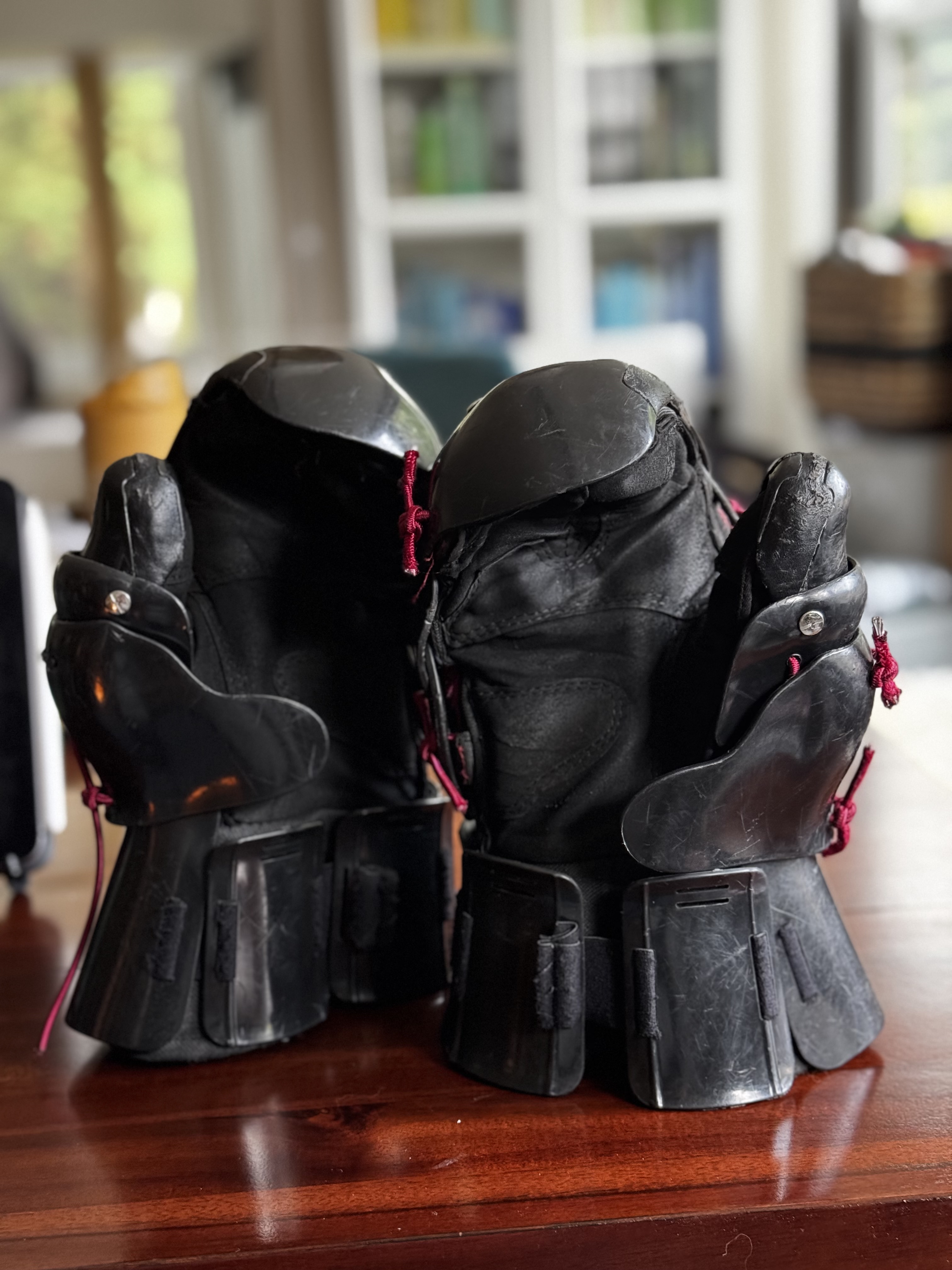
I weighed my Michaels after about two months of use. The pair weighed in at 820 g (left was 409 g, right was 411 g). Both gloves were unmodified. This makes them the lightest hard-shelled heavy glove I’ve tried, and somehow they also come in as the slimmest pair, with a max width of about 5.1” (12.9 cm).
| Model | Weight (g) | Widest Point (cm) |
|---|---|---|
| CHFG Michaels (L) | 820 | 12.9 |
| HF Black Knights (M/L) | 842 | 14.5 |
| SPES Red Lobsters (M/L) | 1,165 | 16.5 |
| Sparring Glove Mittens (long custom) | 727 | 14.75 |
| ProGauntlets (L) | 992 | 16 |
The Michaels also passed my synthetic sansibar test, fitting the smaller handle length easily. In fact, the sansibar was more comfortable to hold in the Michaels than in the Black Knights, and thumbing the back of the handle was similarly more comfortable.
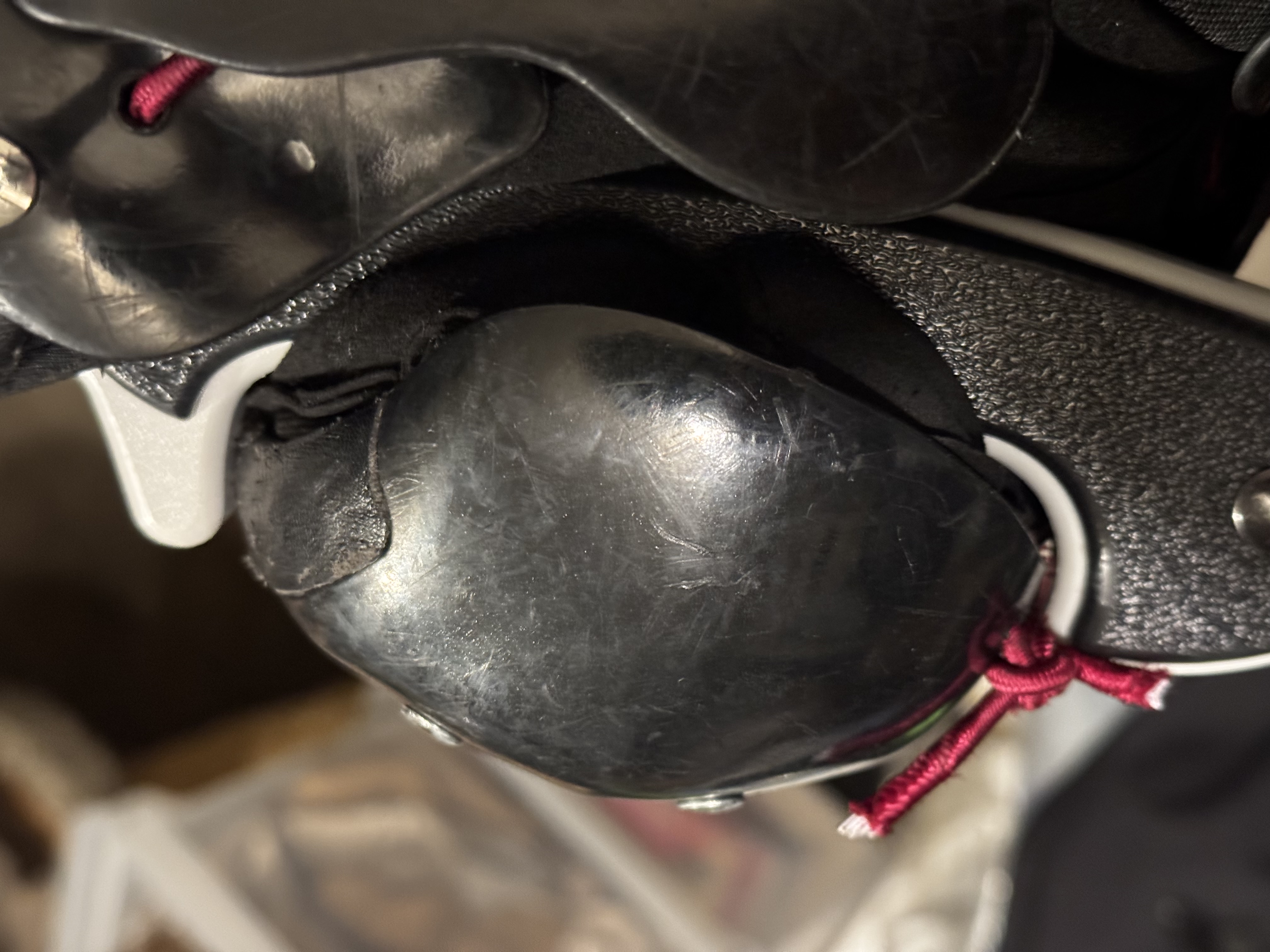
What the Michaels didn’t pass as well was in holding a Cold Steel buckler. While you can still hold the buckler, you can’t get the buckler perfectly perpendicular to your hand, because the top plate of the Michaels bumps into the inside buckler wall. Even though the Black Knights are otherwise larger, they manage this job better, and so when I play sword and buckler, I’ll still use my left-hand Black Knight with the buckler, and use my right-side Michael with my sword.
I wouldn’t necessarily discourage anyone from buying a pair of Michaels for this reason alone if you don’t have another glove as a backup, as you can still hold the buckler, but using the Michaels for this is not optimal.
I used the Michaels with several models of steel saber, and the gloves generally fit beneath the knuckle bow, albeit with some compromise to one’s grip. Usually, I find I can get a “hammer” grip, but my hand is kind of locked in that position, so I have less sword mobility and no real possibility to change my grip much. Thumbing the back of the hilt is possible, but doesn’t feel steady enough to me.
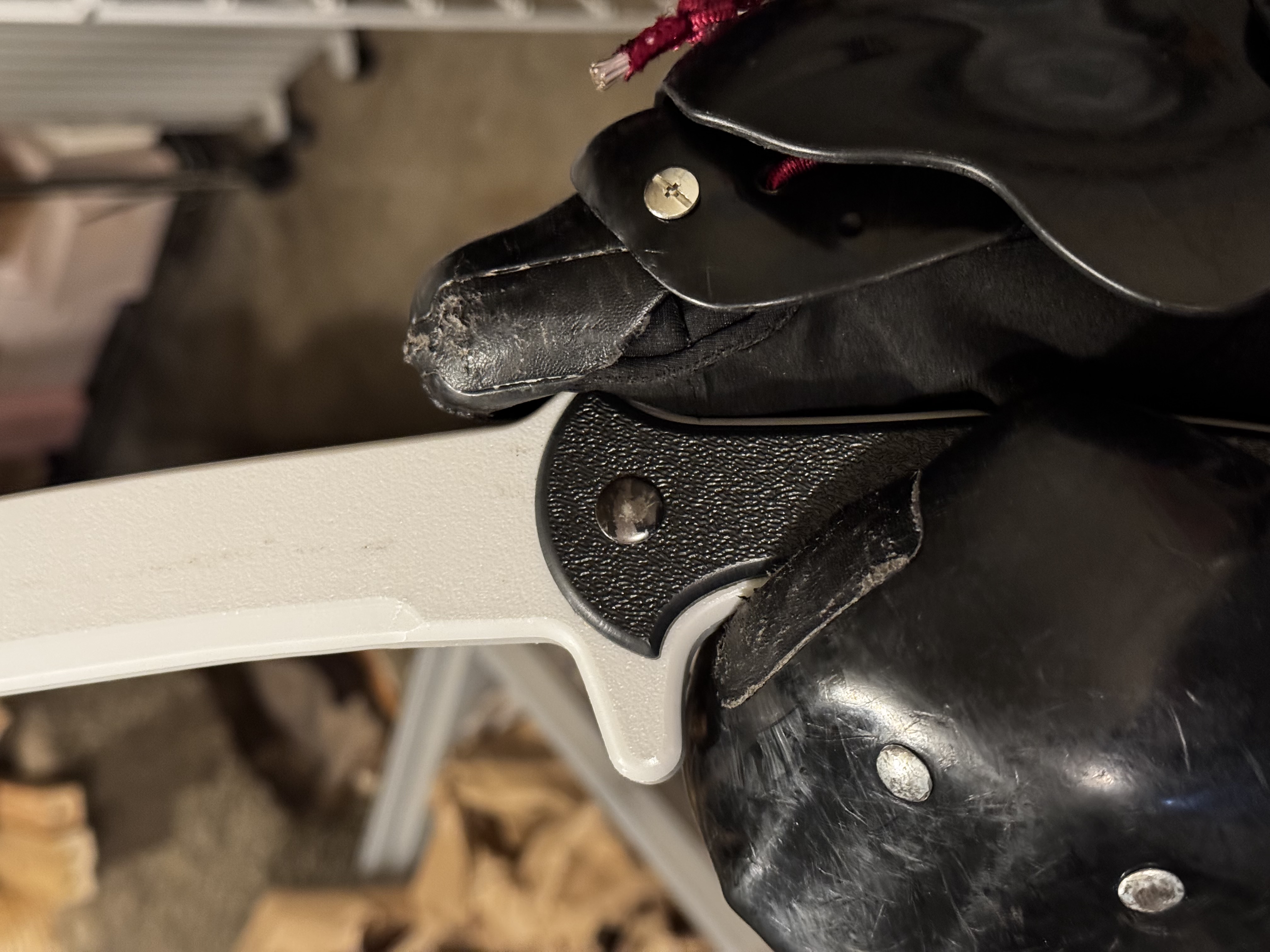
At the two-month mark, my Michaels were holding up great. The underglove had stretched out just enough by this time that my fingers no longer touched the end of the finger pocket when my hand was closed. I noticed some wear on some elastic ties, and I suspected I’d start needing to replace torn ties soon enough. The faux leather patches on the edge of the top plate on my left hand started to see noticeable wear, but the gloves were otherwise in great shape.
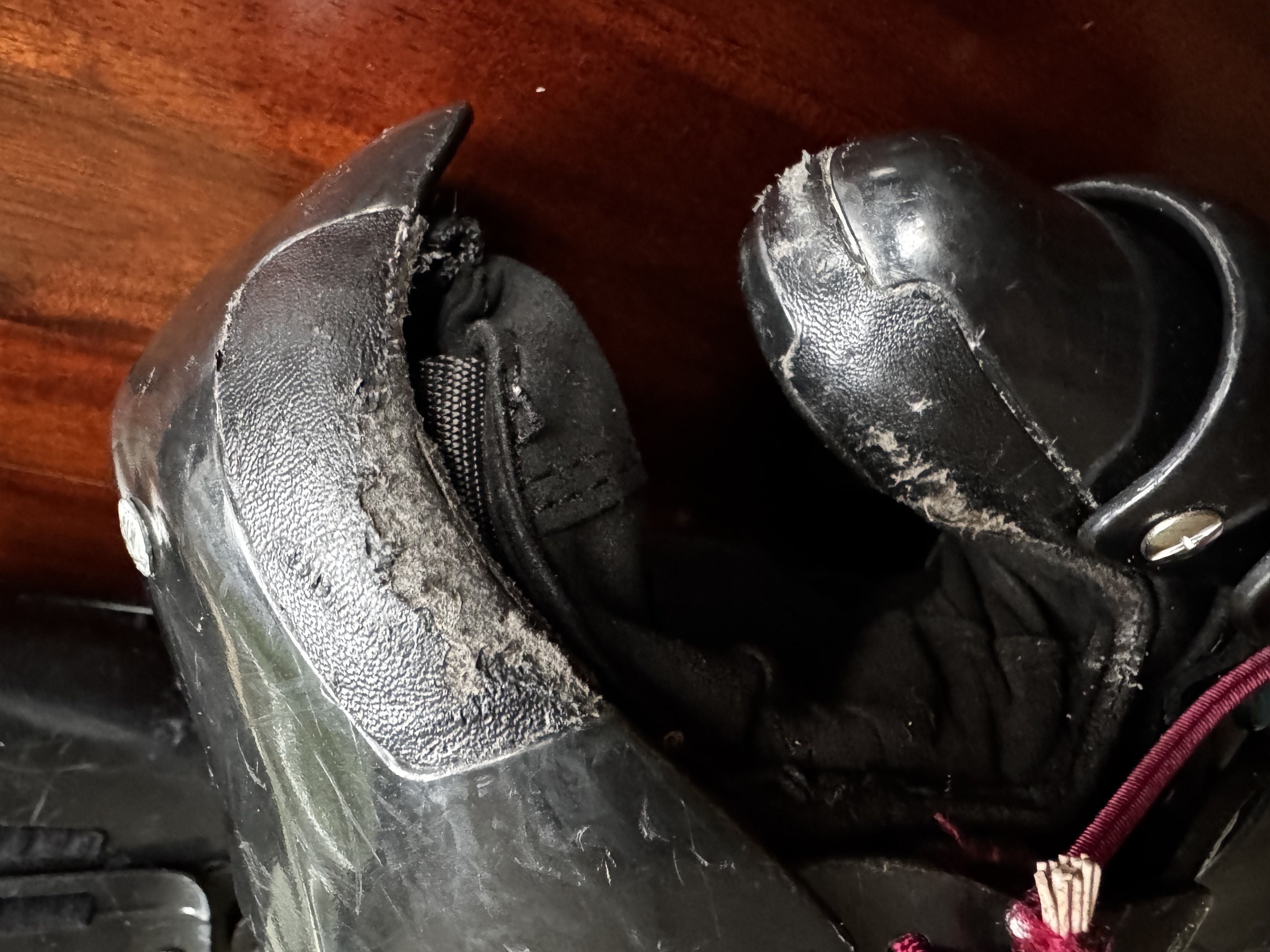
Before month three, I started to encounter torn elastic ties. A torn tie on one of the wrist plates on my dominant hand wasn’t a fight-ender, but a torn tie on my strong-side thumb compromised safety, so I had to bow out of my sparring match to switch gloves. The elastic tie on the side of the index finger, holding the top plate to the underglove edge, also failed on my dominant hand around this same time.
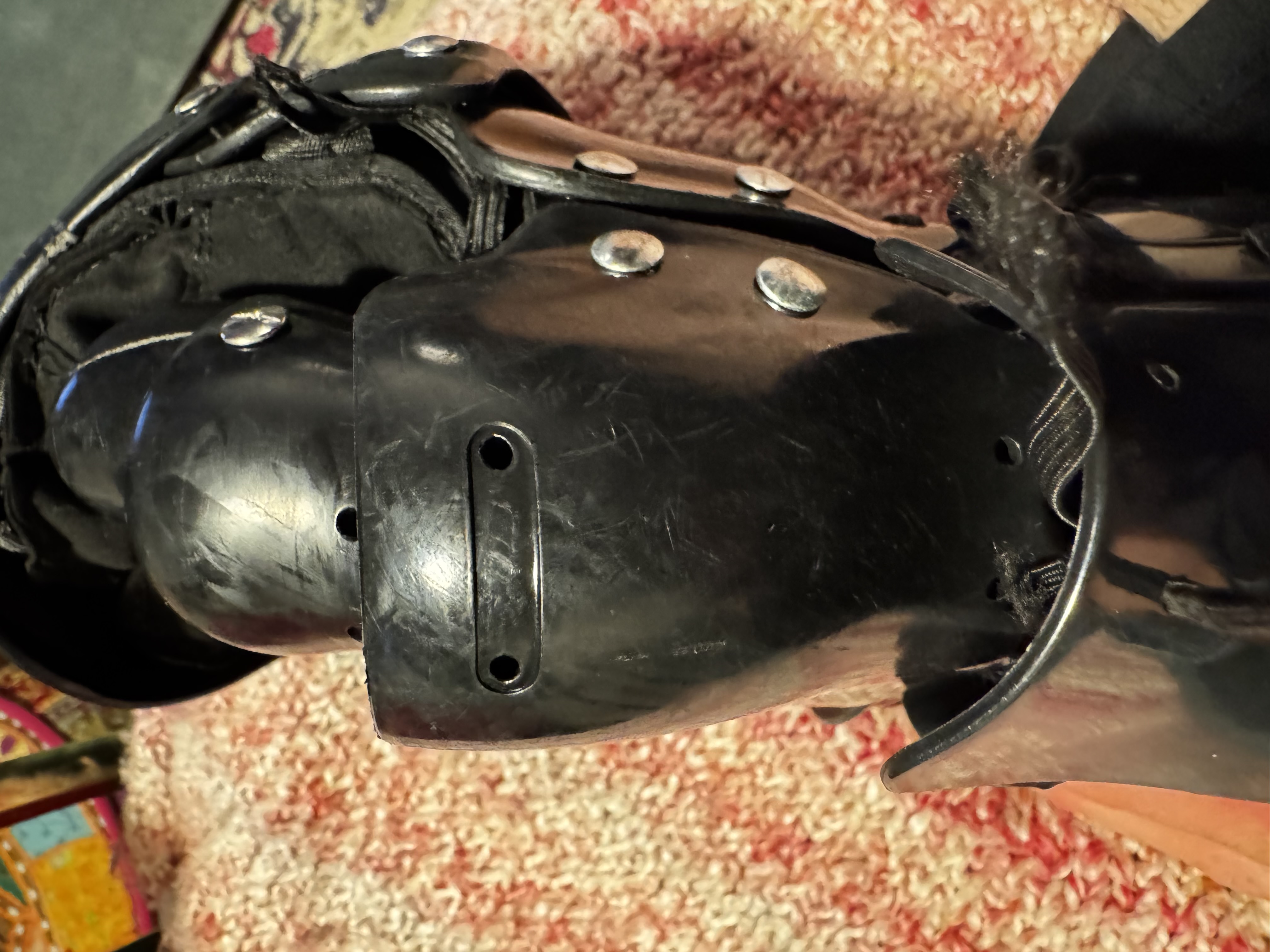
My initial fixes were all made with 1/8” flat elastic hobby cord, which was my mainstay elastic replacement for all of my HEMA kit. Typically, I’d cut a length of this flat cord, tie the ends together so I had a double-run of the cordage, and then use that to replace any torn ties. The flat elastic cord easily fit in the holes, but I quickly found it tore too fast. After only a couple weeks, most of my replacement ties either broke, or saw serious wear such that I replaced it preemptively so as not to have it tear mid-sparring.
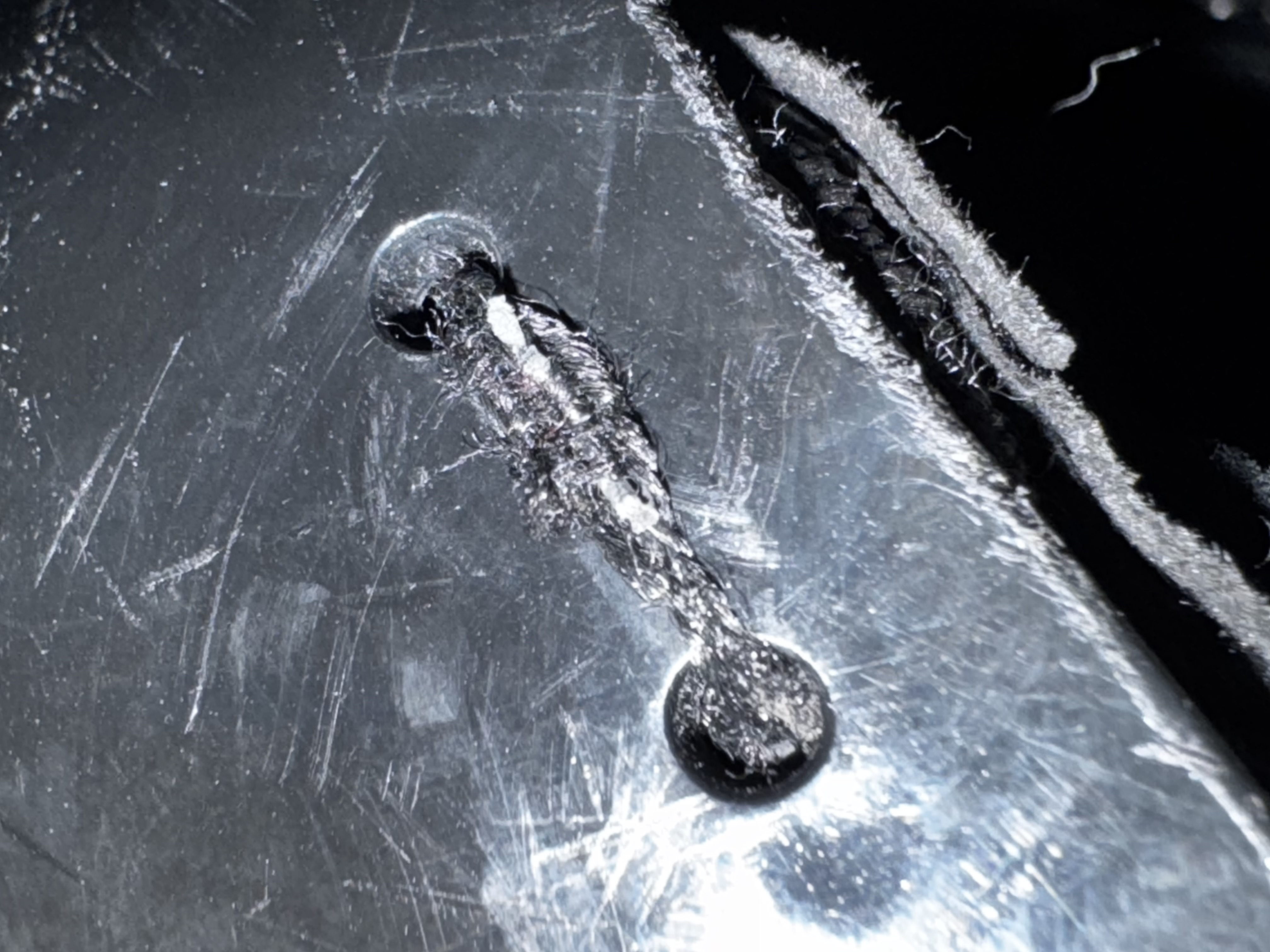
Since I was running low on my flat elastic ties anyway, I ordered 1/8” marine shock cord. A friend had great success with using shock cord on his SGs, using a zeppelin bend to prevent the round cord from slipping loose. Once my shock cord arrived, I unfortunately found it to be too thick to fit the holes in the plastic plates. Instead of waiting on 1/16” shock cord to arrive, I used the awl on my Leatherman to widen the existing holes enough for the 1/8” cord to fit. The plastic proved to be pretty soft, so this process was quick. (In the end, 1/16” shock cord would have been too small to hold things together as snugly, and likely wouldn’t be as durable anyway, so I’m glad I didn’t wait for some to arrive.)

Replacing the elastic cordage keeping the top plate against the edge of the underglove proved a bit more difficult, as the cord is attached to the underglove by winding through a loop of cordura. There’s not enough room to snake in 1/8” round cord here, but CHFG left enough spare cordura here (the ends from forming the stock loop) that I was able to hand-sew one end of the spare end to the existing loop, creating a second, large loop for my 1/8” shock cord to glide through. I’ve named this the “Cordura Mod” for easier reference. I wasn’t happy with tying my shock cord under the glove, so just tied it above the plate, which allows the cordage to freely move through the cordura loop in both directions, as needed.
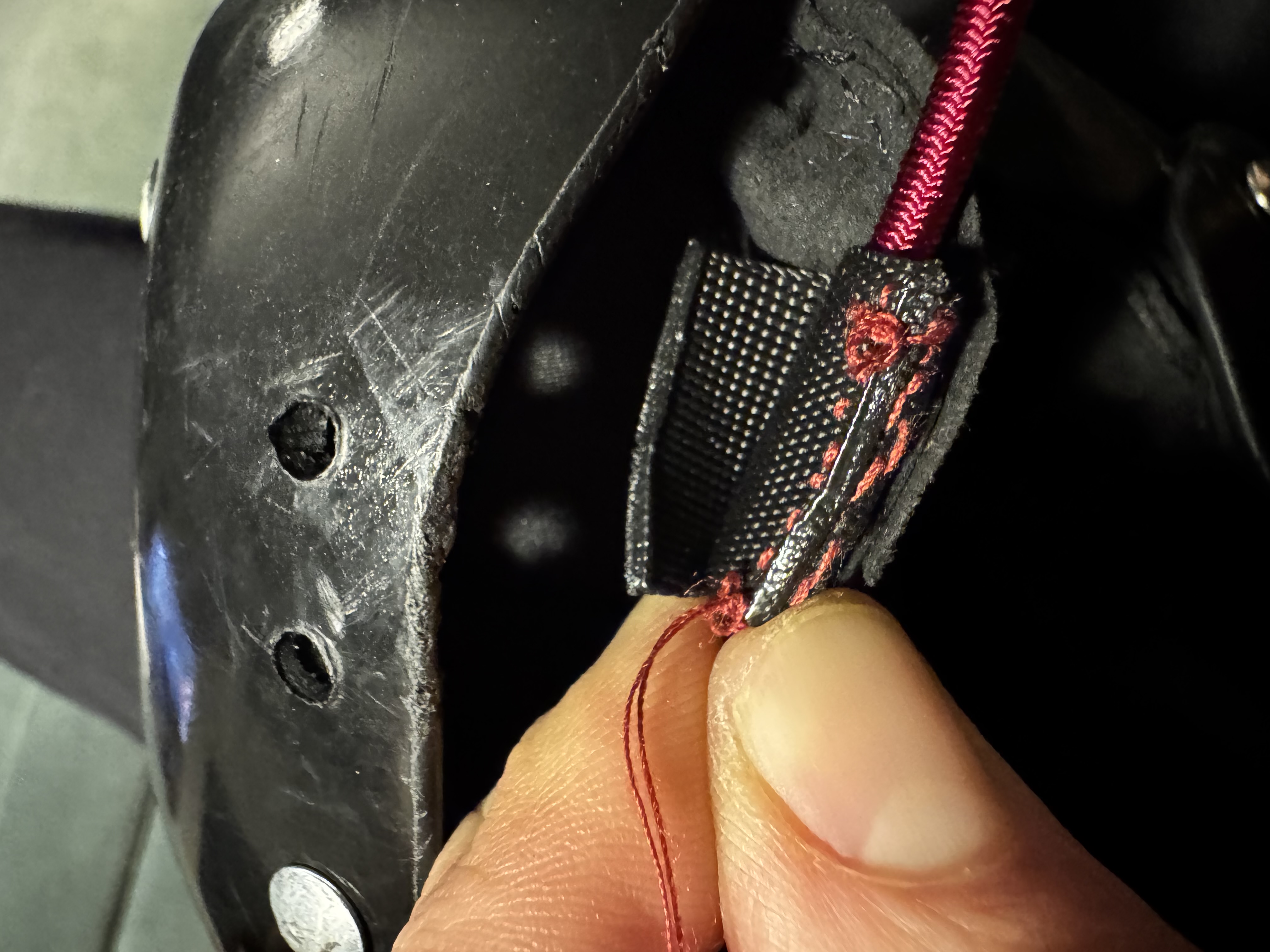 The end of the shock cord ties, being exposed as they are, will fray pretty quickly. It’s no big deal, but if you want a clean look for the life of the cord, passing a lighter over the ends to singe the outer blanket keeps the fraying at bay.
The end of the shock cord ties, being exposed as they are, will fray pretty quickly. It’s no big deal, but if you want a clean look for the life of the cord, passing a lighter over the ends to singe the outer blanket keeps the fraying at bay.
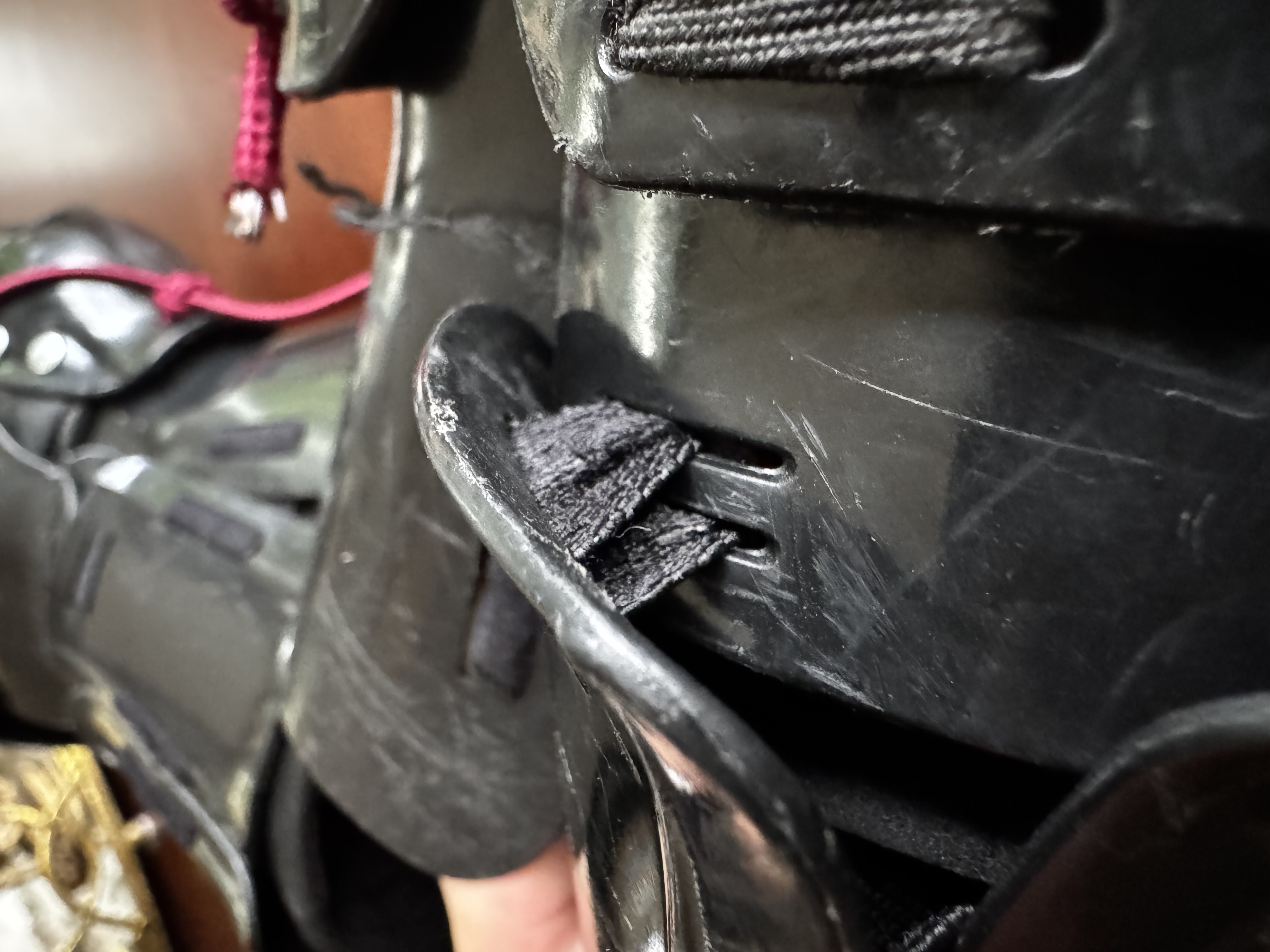
Around the time I did the Cordura Mod, I also noticed that one of the cuff plates on my right glove separated from the wrist plate of the glove. At first glance I thought it was just another torn elastic strap, but it turns out the plastic fin on the wrist plate, which the elastic tie was attached to, actually broke off the glove. The stock ties here are wide flat elastic ties, but since I didn’t have those, I wound a bunch of 1/16” shock cord around the fin on the cuff plate, but since I couldn’t affix it to the fin on the wrist plate, I had to attach it to the bottom of the wrist plate instead.
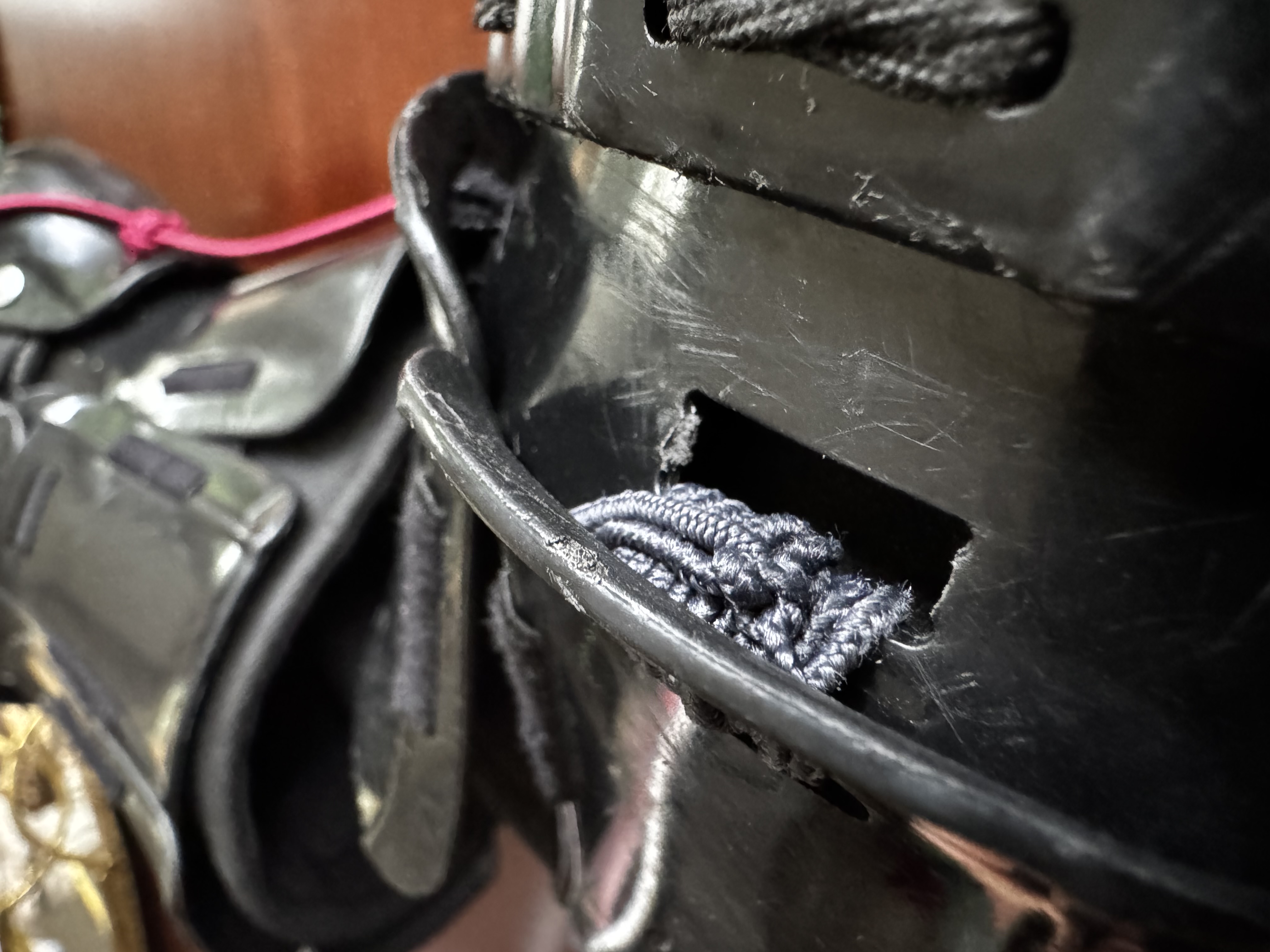 Almost four months into owning the Michaels, the seam on the left hand at the middle finger split open. This happened during a sparring match, causing my finger to slip out of the underglove. I was able to continue fencing, but swapped the gloves out after the match. The seam didn’t open because of a hit or anything specific that happened - I think it was just a bad sewing job. I hand-sewed it closed again, which was a bit of a pain - the underglove is made of a very thin material, but I suspect it’s somewhat puncture-resistant, as I had a tough time getting a regular sewing needle through the material, and ended up bending the needle I was using. A week later, a second seam on the same glove split open, this time for the other pocket where my ring and pinky finger were.
Almost four months into owning the Michaels, the seam on the left hand at the middle finger split open. This happened during a sparring match, causing my finger to slip out of the underglove. I was able to continue fencing, but swapped the gloves out after the match. The seam didn’t open because of a hit or anything specific that happened - I think it was just a bad sewing job. I hand-sewed it closed again, which was a bit of a pain - the underglove is made of a very thin material, but I suspect it’s somewhat puncture-resistant, as I had a tough time getting a regular sewing needle through the material, and ended up bending the needle I was using. A week later, a second seam on the same glove split open, this time for the other pocket where my ring and pinky finger were.
A week or two after fixing these seams, the first fix I made didn’t last, so I had to resew it, this time using waxed cord. The job turned out to be much easier using a sewing awl, and the end result much more durable.
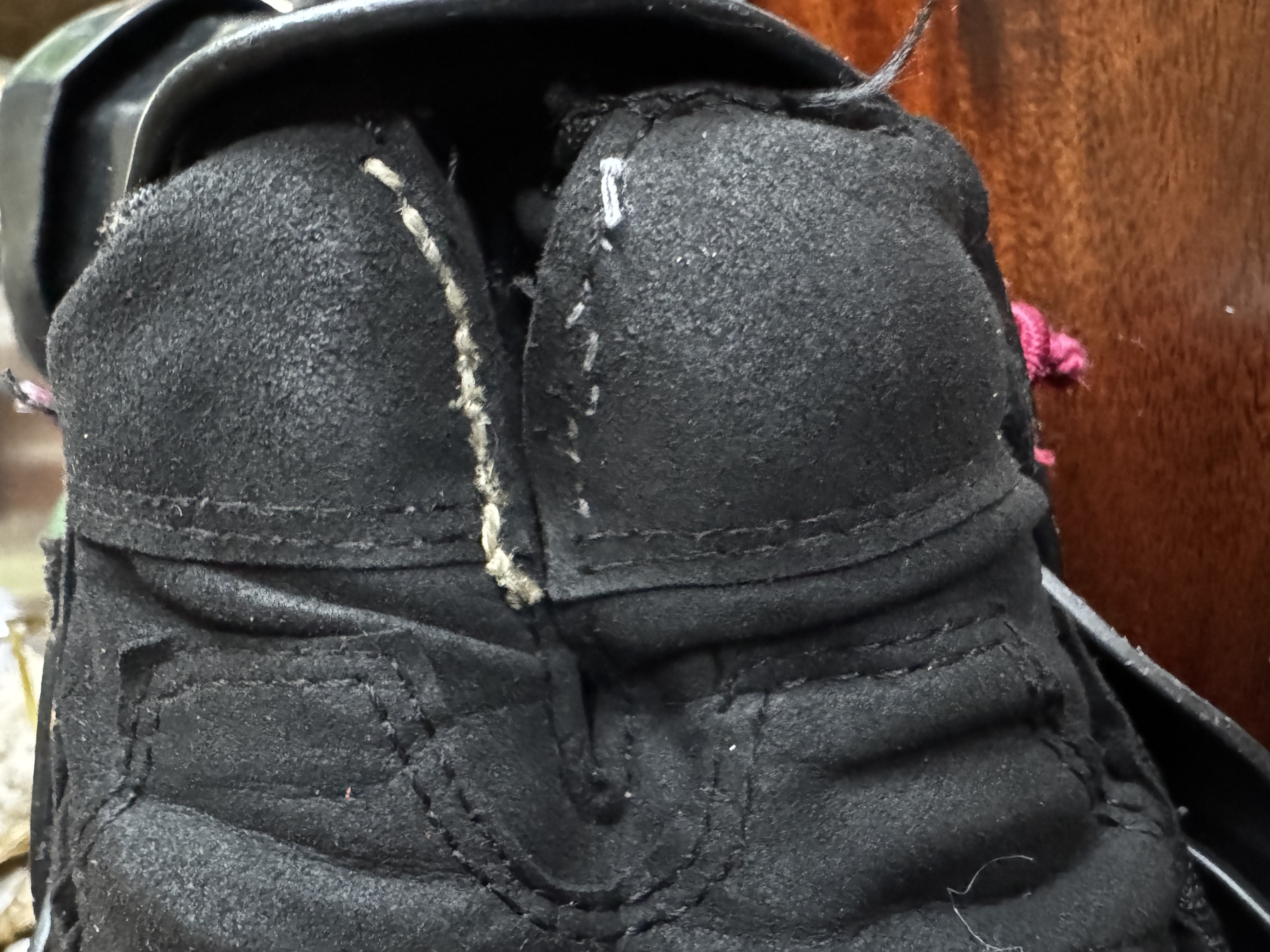
Four months into owning the gloves, I had done the Cordura Mod at every location where the plates attach to the underglove, so as to get the wider shock cord to fit where the thin stock elastic failed. On the plus side, since I used colored shock cord, it became easy to spot my gloves among the other black clamshell gloves at any practice/event . The thicker shock cord is also way more durable than what CHFG provided, so that means less maintenance moving forward.
Around month five, the fabric on the face of my right thumb tore. I don’t know if this was due to general wear, or because of a blade hit, but it’s consistent with reports I heard from others that the underglove wears out quickly. I threw an adhesive patch on the thumb, but due to the type of material the underglove is made out of, it didn’t last long. I ended up sticking another adhesive patch on, putting a second adhesive patch on the inside, and then sewing them together.
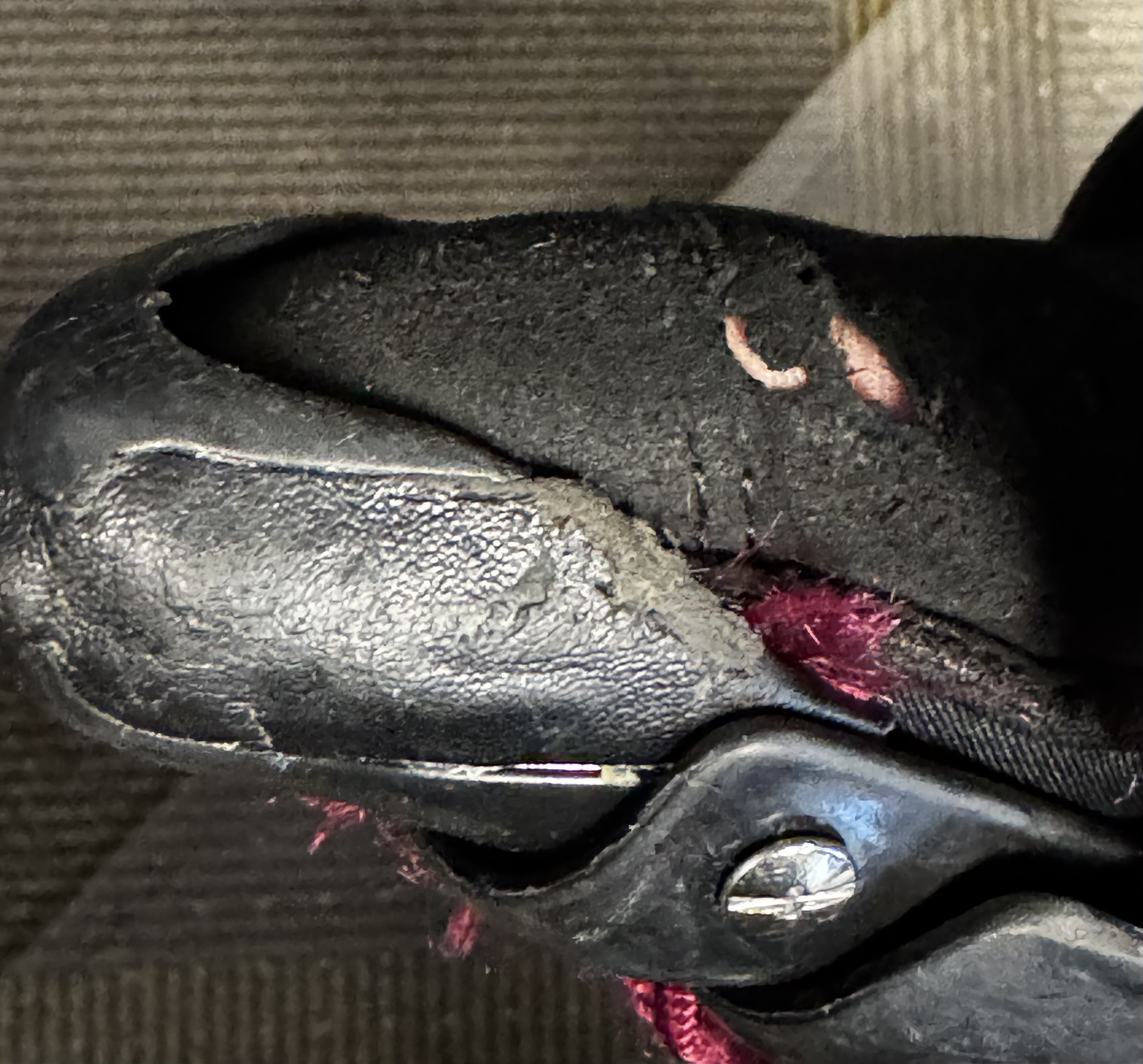
Another fix I had to make on both gloves was a re-attaching a thin strip of foam. The bottom thumb plate was attached to the back-of-hand plate with a piece of leather-looking material riveted to both plates. A small foam rectangle was glued to the inside of this piece, but the glue didn’t last, so on two separate occasions, the foam rectangle just fell out of each glove. The foam on the right glove came out first, and a few weaks later, it was the one on the left glove. The foam piece has stamped holes in each corner which line up with the rivets, so I wonder if the intention was for the foam to be glued to the leather, and then riveted in place, but for whatever reason this didn’t happen during assembly, so it was just glued on over the rivets as a last-minute fix.
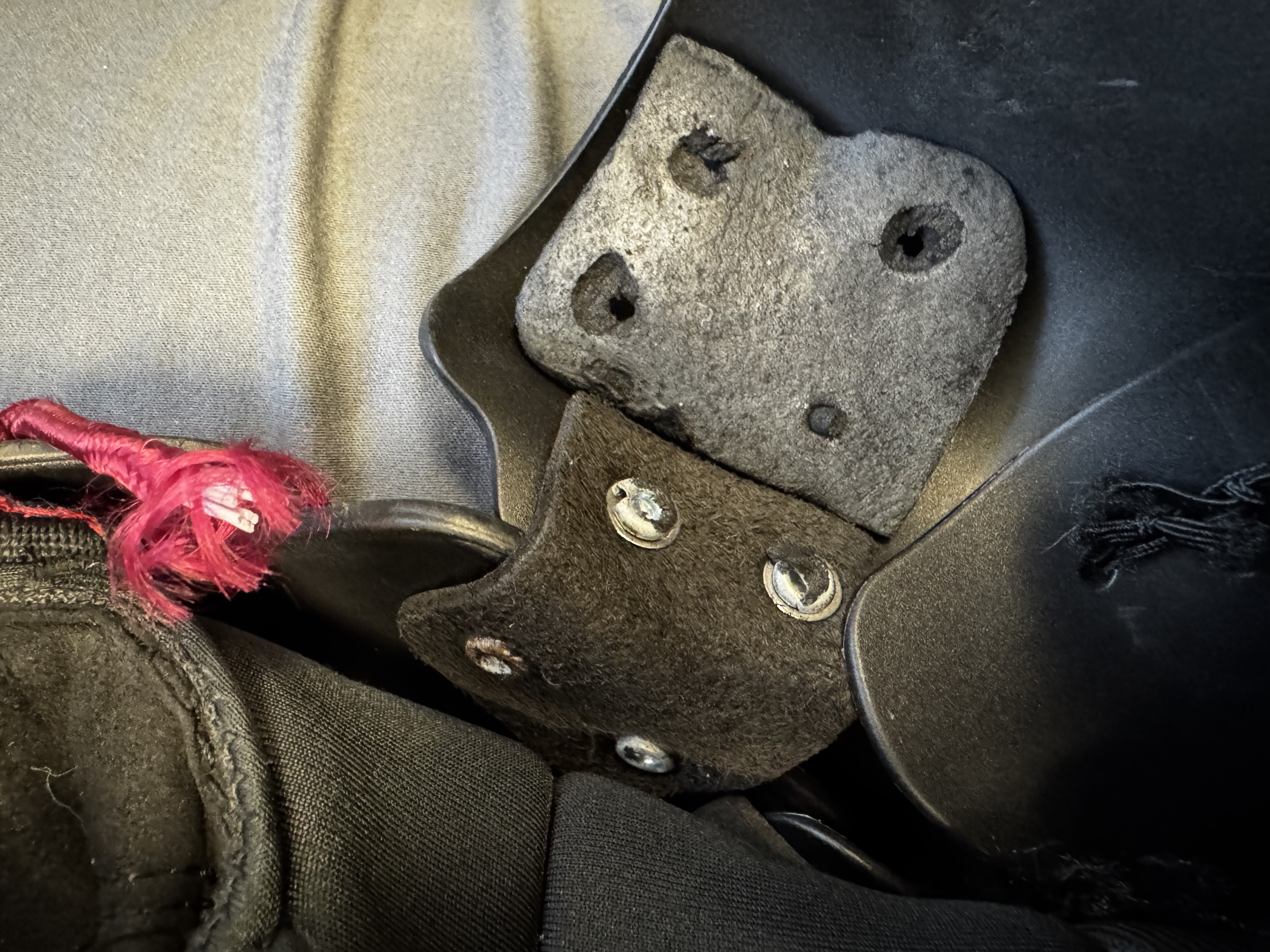
A little bit of E6000 glue fixed each piece of foam, but the foam isn’t particularly strong, and after gluing the right one into place, I noticed it’s started to tear in half. This foam presumably adds an extra bit of impact protection, so I thought I’d need to find something more durable here in the coming months.
An issue I haven’t personally experienced but a friend has, is separation of the underglove thumb from the plastic plate. The tip of the thumb is attached to the plate via some sort of threading or cap, and the faux leather covers this connection point. If that attachment to the underglove gives, the fix is apparently not straightforward or easy.
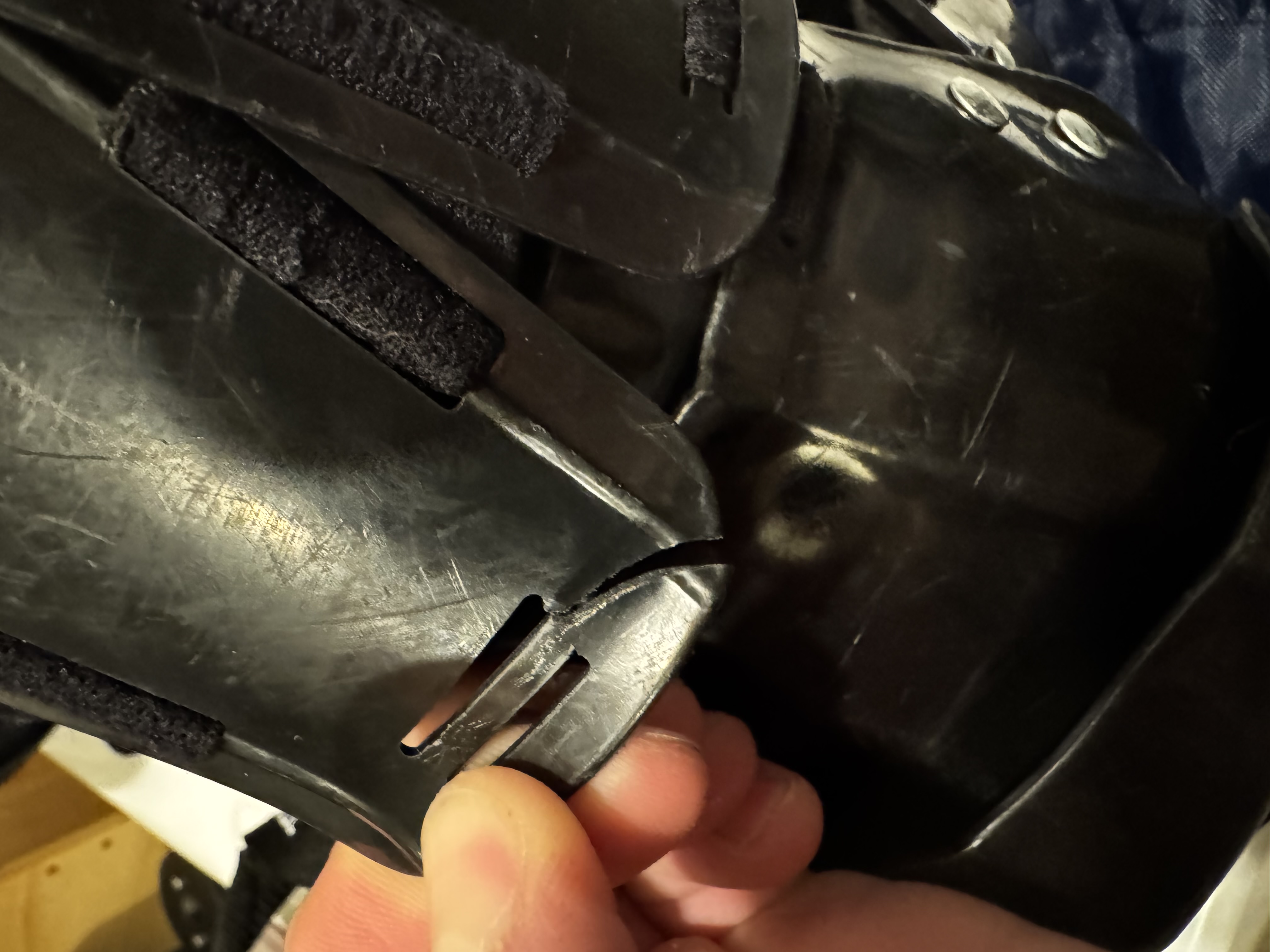
About a week after posting the first version of this review, my right glove unfortunately suffered two more cracks. One was at the top end of a cuff plate, causing it to detach from the glove body. The second crack was at the tip of the thumb. I was told a newer version of the Michaels would have a different thumb design inherited from the Gabriels, which shouldn’t crack as mine did. I wasn’t particularly keen on patching the damage to the thumb with tape which was what was recommended to me, so I ended up sending my Michaels in for warranty replacement.
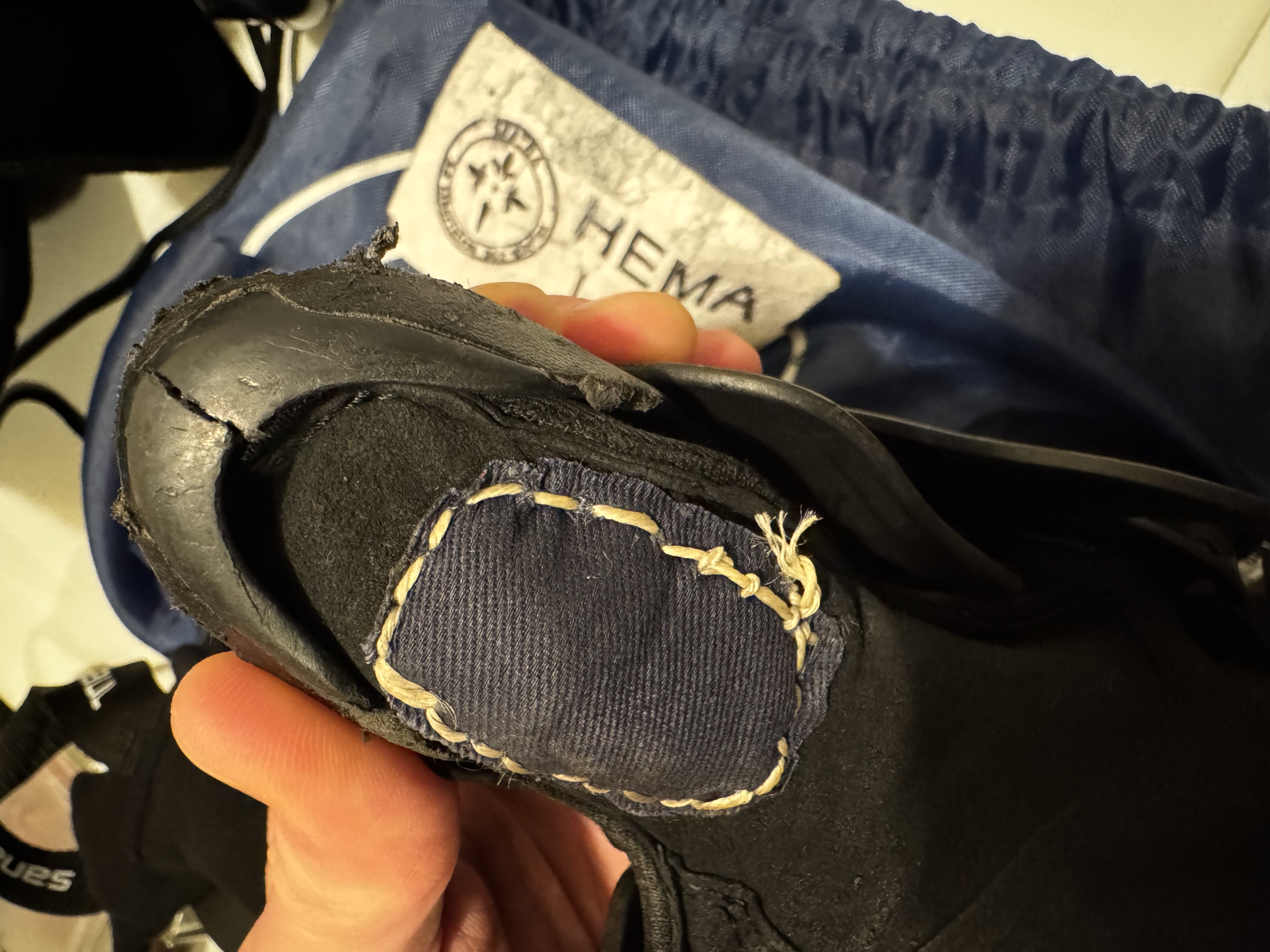
Of note is that per SoCal Swords, the warranty on these gloves is one year. When I contacted SoCal Swords by email, they responded pretty quickly, and gave me an address to send the gloves to. I waited until they had new Michaels in, sent mine back, and received my M2s with little delay. Fortunately, I had my backup pair of BKs, so was only without the Michaels for a couple weeks.
Notable on my M2s is that the thumb design was indeed changed, and it seems both more protective and more durable. Another change on the M2s is that the leather riveted square with the glued on foam was swapped out with a plastic square with more elastics. That means the design on the M2s is arguably easier to fix if something goes wrong, but relying on even more elastics means more will go wrong, and I quickly found this out as the stock elastics quickly slipped free after a week of sparring. There‘s also no foam here anymore, so if it did anything previously, you’re lacking that impact protection now.
A seam on my left-hand M2 opened after only two weeks of use, which strongly suggests to me that quality control is not great. One of the stock elastics also tore the first week, which gave me an excuse to consider doing the Cordura Mod. When I examined the stock cordura loops, I pleasantly found that they’re now sewn a bit larger, so I didn’t need to do any sewing to get my shock cord through (though it was still a tight fit). I still had to use an awl to enlarge the holes on the plastic shell, though.
The protection offered by the Michaels is generally comparable to the Black Knights, and like most other hard-shelled gloves, prevent most hits from causing any pain at all.
Just before transitioning to the Michaels, I suffered a couple painful hits in my BKs beneath the plastic plates and to the underside of my strong-side thumb. I haven’t experienced such hits in the Michaels at all, so either my hand positioning has improved coinciding with the switch in gloves, or the Michaels directly contributed to less hand injuries either by directing my hand movement in some beneficial way, or actually causing hits to land differently.
The only painful hits I received in my first pair of Michaels was an occasional hit beneath the front of the plate at my index/middle finger, or to the tip of my thumb. The plate that covers the finger plates curves in a decent amount which is nice, but as the underglove stretches, if your fingers aren’t firmly seated at the end of the underglove, the tips of your fingers curve in a bit and are more likely to get hit if your grip is sufficiently loose. Taping around the glove to keep your fingers against the plate as much as possible may rectify this.
Similarly, the tip of my thumb was hit because it slipped a little down the thumb pocket as I loosened my grip, and as I curled my thumb, it was no longer fully covered by the lip of the plastic plate. Taping around the thumb to keep it from bulging through the underglove may better protect the inside of the thumb if your thumb tends not to fully wrap around your hilt, or hangs loose between a thumb grip and regular grip.
I’m also pretty sure I took a hard wrist shot or two, which I attribute to overall weaker protection offered by the Michael wrist plates. I don’t love the design of the wrist plates, and could stand for the wrist portion of the glove to flare a bit less; I suspect a sword impact to the wrist is more notable because of the plate stand-off, so the plate itself comes crashing down onto the wrist with the sword, instead of the plates already being pretty flush with my arm. Admittedly though, my jacket sleeves should be a tad longer, so in a properly-sized jacket, maybe this would be less of an issue for me since I’d have some added padding at the wrist. That said, I also don’t love how the cuff plates attach, and how there’s not a lot of overlap between them.
The shape of the thumb plate is really good, as it bends over the tip a bit unlike the thumb plates on other gloves like the SG Mittens or HF Black Knights. It’s a thoughtful addition, and while CHFG weren’t the first to do this, I’m glad they’re using this innovation. The thumb cap on my M2 is even better.
On my M2 gloves, I took a hit to my non-dominant pinky after only about two weeks of using the gloves, which caused the skin to break open and my finger to bleed. There was no damage to the glove though. That same week, I somehow took a hit to the tip of my strong-side middle finger also, causing a bruise under the nail. I subsequently took more shots to this area to cause more bruising, and my only guess upon inspecting the glove is that my middle finger bumps against an inside seam here, and it’s somehow affecting how the glove is transferring force to my finger.
The Michaels are often touted as comparable to the Black Knights, but I think this statement deserves a huge asterisk. You ultimately get better thumb mobility and protection in the Michaels, but at the cost of more upfront modification and fixes. Some of this maintenance will be ongoing, but at least it’s simple. If the plastic breaks though, you’re in a bit of a pickle unless you’re under warranty.
In comparison, the Black Knights are ultimately a more durable option, with at least two design weak points that may require fixes sooner or later. The mods you may have to do on the Black Knights require more tools and components, but once they’re done, you’re generally good to go; the Black Knights require far less long-term maintenance than the Michaels. Further, if you mod the Black Knights early, before there’s a problem, the Black Knights prove to be a far more bulletproof glove, which won’t take you out of a sparring match because of a broken elastic bit causing a plate to hang.
That said, if you’re one of the unlucky few Black Knight owners that have wrist rivets fail, it’s not an easy fix to do at an event. Whereas most issues on the Michaels can be fixed in-between matches with just some spare elastic, they too have the potential to fail at the wrist, which again is not an easy fix.
Since I already did the mods needed on the Michaels, I was pretty happy with them until the wrist plate and thumb cap broke, and I preferred them in regular use over the Black Knights. For the Michaels specifically, I’d strongly suggest that as soon as your first strap at a cordura loop tears, to just do the Cordura Mod at every attachment point, on both gloves, and swap out all the elastics with thicker 1/8” shock cord in one go. It’ll be a full evening of work, but you’ll get the aggravation out of the way early. If you have a version of the 2025 Michaels, it’s even less for you to do, since the stock cordura doesn’t need any modification, and all you need to do is widen the holes in the plastic.
Comparing both a modded pair of Black Knights and a modded pair of Michaels, the Black Knights have an advantage in that the underglove is much more durable. Of course, holes can be patched without too much effort. The Black Knights can have issues with wrist rivets or the textile on the underside of the thumb tearing away from the rivet holding it in place, and the Michaels have their own potential thumb issue with the underglove tearing away. If it weren’t for the weaker plastic on the Michaels, I would have given them the nod, especially since they have twice the warranty period of the Black Knights, and most fixes are easier for the average user to do. But the weaker plastic is just a no-go, and it’s hard to recommend a glove with this many problems after six months of use. Further, if you fence in cold weather, the plastic used on the Michaels seems to have an issue with becoming brittle, which makes it even worse.
If you spar with enough intensity and regularity that you know you’ll likely need/want a new pair of gloves every six months to a year, regardless of model, go ahead and consider the Michaels but have a backup pair of gloves handy. They’re way more comfortable than the Black Knights, and you can probably patch enough things up to keep them in service until you’re ready to get a warranty replacement. Of course, getting a warranty replacement is based on available stock, and if that works in your favor, you’re now back to square one with not having the aforementioned mods done, so be prepared to spend more time on the couch with your repair bits at your side.
In the end, despite their own flaws, the Black Knights still win for overall durability. They were my backup pair of gloves, and they were dutifully pressed back into service until my M2s arrived. That’s saying a lot. While I’m back to using Michaels, I’m skeptical they’ll last another six months, and am reaching for the BKs more often now.